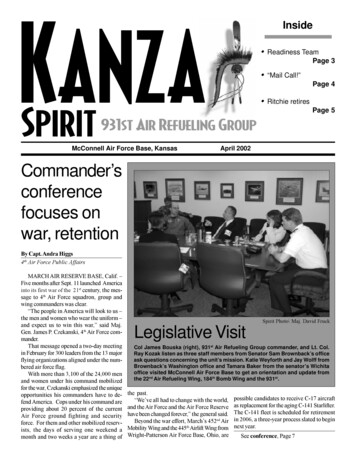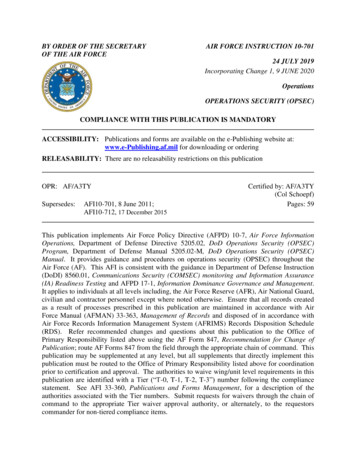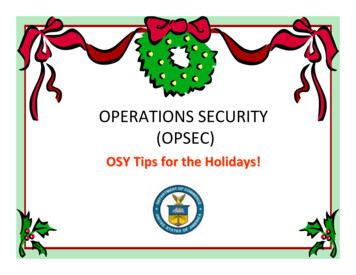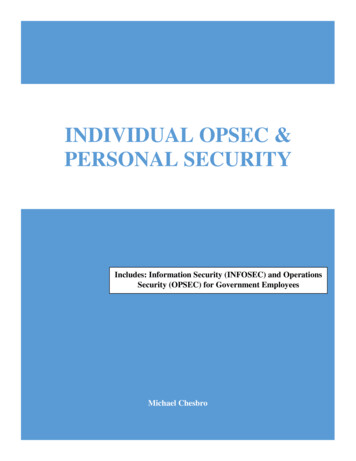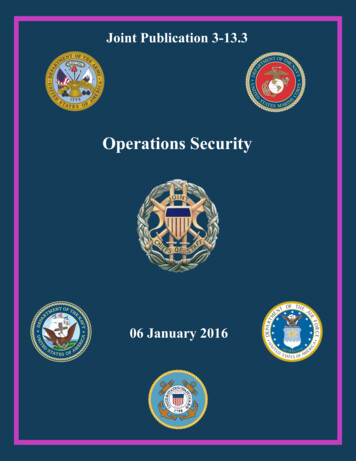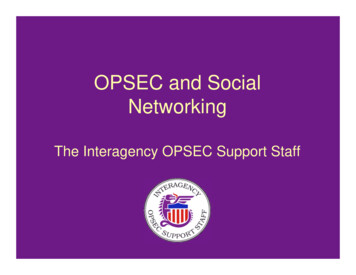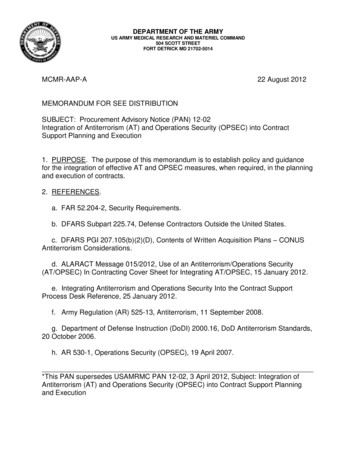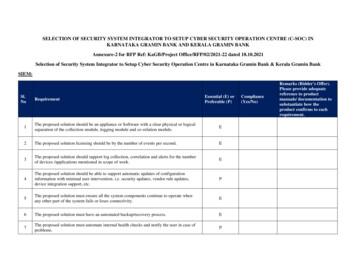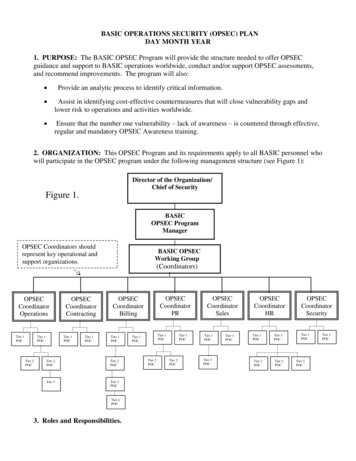
Transcription
BASIC OPERATIONS SECURITY (OPSEC) PLANDAY MONTH YEAR1. PURPOSE: The BASIC OPSEC Program will provide the structure needed to offer OPSECguidance and support to BASIC operations worldwide, conduct and/or support OPSEC assessments,and recommend improvements. The program will also: Provide an analytic process to identify critical information. Assist in identifying cost-effective countermeasures that will close vulnerability gaps andlower risk to operations and activities worldwide. Ensure that the number one vulnerability – lack of awareness – is countered through effective,regular and mandatory OPSEC Awareness training.2. ORGANIZATION: This OPSEC Program and its requirements apply to all BASIC personnel whowill participate in the OPSEC program under the following management structure (see Figure 1):Director of the Organization/Chief of SecurityFigure 1.BASICOPSEC ProgramManagerOPSEC Coordinators shouldrepresent key operational andsupport organizations.OPSECCoordinatorOperationsTier 1POCTier 1POCTier 2POCOPSECCoordinatorContractingTier 1POCTier 1POCBASIC OPSECWorking torBillingTier 1POCTier 2POCTier 2POCTier 3Tier 3POCTier nPOC3. Roles and Responsibilities.Tier 1POCTier 1POCTier 2POCTier 1POCTier 2POCOPSECCoordinatorSalesTier 1POCTier 2POCTier 1POCOPSECCoordinatorHRTier 1POCTier 2POCTier 1POCTier 2POCOPSECCoordinatorSecurityTier 1POCTier 2POCTier 1POC
3.1 OPSEC Program Manager. The BASIC OPSEC Program Manager is responsible for developingthe OPSEC Plan and monitoring its implementation and operation to ensure compliance. He serves asthe principal advisor to the Chief of the Organization and/or Chief of Security on all OPSEC mattersand will:1) Coordinate all OPSEC policy responsibilities and procedures within the program.2) Revise the OPSEC Plan as necessary, including the critical information lists, threatassessment, vulnerabilities, risk, and countermeasures.3) Accumulate and disseminate updated threat information and awareness materials to programpersonnel.5) Assist in the review of contract requirements for OPSEC considerations.6) Ensure that the OPSEC Coordinators and selected POCs will complete OPSEC training todevelop skills, which may include the following: Threat assessment;Identification of unclassified critical information;Identification of OPSEC indicators;Analysis of OPSEC vulnerabilities;Assessment of risk;Countermeasures development and implementation;Contingency and emergency planning; and,Awareness training development and presentation.Training may be computer-based (CBT) or delivered via instructor-led briefings.7) The BASIC PMO OPSEC Program manager will provide to the OPSEC Coordinators: theBASIC OPSEC Plan with generally written annexes and updates (unclassified criticalinformation list, threat information, vulnerabilities, and the OPSEC SOP (countermeasures)),awareness training software, and/or other awareness materials, as appropriate. CriticalInformation Lists, threat, vulnerability and countermeasures should be coordinated withpersonnel from the lowest possible tier to ensure effectiveness.3.2. OPSEC Coordinators. The OPSEC Coordinators will successfully complete OPSEC training.The role of the OPSEC coordinator is to provide OPSEC oversight for the lower tier levels and tointerface with the OPSEC Program Manager to elevate issues that affect BASIC at large. OPSECCoordinators will be responsible for awareness training, identification of critical information lists andcountermeasures, other OPSEC issues and vulnerabilities, and implementation of OPSEC policies andprocedures, and will work through OPSEC Points of Contact (POCs) who are identified in lower tiersof the company. The OPSEC Coordinators will maintain employee training records which must bemade available if they are requested from the BASIC OPSEC Program Manager. They will ensure thatany OPSEC issues that are identified by OPSEC POCs or personnel are provided to the BASICOPSEC Program Manager. These may include the identification of potential unclassified criticalinformation items, vulnerabilities, and/or countermeasures that may need to be addressed.3.3. OPSEC Working Group. The role of the OPSEC working group is to ensure the BASICOPSEC Program implementation is consistent across the organization, and is integrated at the working
level. The working group will also assist the OPSEC Program Manager to develop generalcountermeasures and solutions. The working group will provide coordination of all recommendationsbeing forwarded to senior leadership, and will assist with development of briefings and reports.4.POLICY: All mandated areas in the company will participate in the OPSEC program.4.1. All personnel will receive OPSEC orientation training within [30/60/90] days ofassignment. OPSEC coordinators will conduct initial orientation training using materials provided bythe OPSEC program manager.4.2. All personnel will participate in [annual/biannual/quarterly/monthly] OPSEC awarenesstraining. Coordinators will ensure that attendance for all personnel in their department is documented,and will provide a memo to that effect to the OPSEC Program Manager within [10/30] days of thetraining.4.3. The OPSEC Program Manager will participate as an emergency actions team member,and will provide appropriate OPSEC analysis support and countermeasures recommendations.4.4. The OPSEC Program Manager will brief the Chief of the Organization on OPSEC issuesand changes to the intelligence threat [periodically/weekly/monthly/quarterly].4.5. Each company department will provide a senior representative to the OPSEC workinggroup. Managers will ensure the working group representative is replaced should the assigned personbe unable to participate due to extended illness, extended travel requirements, or reassignment.Working group members will attend training as determined by the OPSEC program manager.4.6. Each [division/branch/functional area] will provide one or more OPSEC coordinatorsdepending on size and responsibilities of each element. The OPSEC Program Manager will ensure thatthe OPSEC coordinator is replaced should the assigned person be unable to participate due to extendedillness, extended travel requirements, or reassignment. OPSEC coordinators will attend training asdetermined by the OPSEC program manager. OPSEC coordinators will provide reports, assist withorientation and awareness training, and perform other OPSEC functions as determined by the OPSECprogram manager.4.7. All personnel will be familiar with the critical information list for their department orprogram, and will be prepared to describe appropriate OPSEC countermeasures they can apply toprotecting that information in accordance with their awareness training.
5. REQUIREMENTS:5.1. OPSEC Process.5.1.1. Unclassified critical information. An unclassified criticalinformation list and updates will be provided under separate cover (Annex A) to the OPSECCoordinators for dissemination to employees in their respective department. For maximumeffectiveness, the critical information list should be developed at the lowest possible tier.5.1.2. Threat Assessment. Capable adversaries collecting unclassified, as well asclassified, information on BASIC and companies developing similar technologies may pose a threat tothe BASIC company, its employees, customers, partners and vendors. A formal threat assessment andall updates will be provided under separate cover (Annex B) to the OPSEC Coordinators fordissemination to OPSEC POCs in lower tiers, as necessary. A general threat assessment is providedbelow.5.1.2.1. General Threat Assessment. The worldwide intelligence collection threat iscomprised of multi-disciplined, highly sophisticated, and extremely dedicated adversaries. There is aconsensus within the U.S. Intelligence Community that their collection efforts target almost all DoDcontractors developing new technologies. Any business enterprise operating in the global competitivemarket should recognize that it is continually targeted by intelligence collection efforts. Adversariescan produce reliable information on business capabilities, vulnerabilities, and intentions. Moreover,the intelligence threat to the U.S. economic and scientific base has actually increased dramatically inrecent years.5.1.3. Vulnerability Analysis. Vulnerabilities (and indicators) of the program may revealunclassified critical information. A general and contractual vulnerability analysis is provided below.5.1.3.1. General Vulnerability Analysis. The following general vulnerabilities are mostcommonly identified in an OPSEC assessment. Lack of OPSEC Awareness. Personnel do not fully realize their OPSECresponsibilities. Employees are not aware of the extent to which adversaries dependon obtaining unclassified information on a defense project and their capabilities toderive important intelligence data from seemingly non-unclassified criticalinformation. Testing. Subsystem testing may be vulnerable to exploitation. Open Source Information. Unclassified information released to the news media (i.e.,through meetings, seminars, conferences and exhibitions, contractor advertisements,company websites, blogs, emails, professional journals, research papers, conferencepresentations, resumes, newsletters, annual reports, etc.) may provide adversarieswith valuable information regarding individual systems capabilities, limitations andtechnical operations. Professional Conferences/Symposia. Company personnel are susceptible toelicitation and exploitation when attending these events by fellow participants whocovertly represent the intelligence collection agencies of foreign governments.
Collection efforts may range from innocuous questions from foreign scientists toblackmail by intelligence agents. Without constant awareness of the threat, projectpersonnel may inadvertently release information of analytic value. Communications. All unsecured telephone conversations, including faxes, cellphones and Voice over IP conversations, are vulnerable to monitoring. Email andattachments are also vulnerable to interception and monitoring. Such vulnerabilitiesprovide a source of information for intelligence agents and other adversaries. Contracting. Companies may fail to recognize the need for the imposition ofOPSEC requirements in contracts and subcontracts. Visitor Control. Visitors within the facility may observe or overhear unclassifiedcritical information regarding operations, activities, etc. Conference Room Security. Unclassified critical information can be compromised ifthere are no procedures in place to control discussions. Unclassified criticalinformation can be compromised by covert listening devices installed in meetingrooms frequently used for discussions. Disgruntled Employees and Employees with Personal Problems. Personnelpossessing security clearances may, through personal adversities or circumstancessuch as marital difficulties, criminal behavior, excessive indebtedness, and/orindiscriminate use of alcohol, present attractive targets to intelligence services.Supervisors and/or fellow employees may become aware of these difficulties butmay fail to notify management or security to investigate, electing to ignore theproblem or rationalizing that some other party will take action. Non-action on thepart of personnel who become aware of these situations can be as significant as thatpresented by an adversary who may attempt to exploit personnel experiencing theseproblems.5.1.3.2. Contractual Vulnerability Analysis. The following contractual vulnerabilitiesare most commonly identified in OPSEC assessments: Use of an external travel office; travel patterns, and travel practices;Geographic separation of various corporate locations;Sympathies of personnel for adversary countries;Communications between test sites and program offices following testing;Lack of procedures or failure to comply with those developed for controllingvisits;Lack of procedures or failure to comply with procedures regarding informationrelease to international partners and subcontractors; and,Unauthorized access to specific unclassified performance parameters related oridentified with the program.5.1.4. Risk Assessment. The BASIC OPSEC Program Manager has determined thatcertain risks associated with vulnerabilities and indicators are unacceptable and must be mitigatedthrough countermeasures.
5.1.5. Countermeasures.5.1.5.1. Awareness Training. OPSEC Coordinators will provide computer-basedtraining (CBT) or briefings for their personnel and will ensure that the unclassified critical informationlist, threat information, and list of countermeasures in the form of an OPSEC SOP (Program PlanAnnex C or one tailored to the department) are provided to personnel and/or OPSEC POCs. Inaddition, they will provide contact information for reporting and feedback.5.1.5.2. General Countermeasures. In conjunction with OPSEC awareness training, anOPSEC SOP (OPSEC Plan Annex C or one to tailored to the department) will be distributed topersonnel and/or OPSEC POCs. The OPSEC SOP will include the following general countermeasuresto be applied whenever personnel handle unclassified critical information or indicators on theunclassified critical information list: Secure electronic transmission and storage of unclassified critical information.Unclassified critical information must be transmitted and stored in accordancewith the OPSEC SOP. If there is a question of conformance or practicability, theBASIC OPSEC Program Manager must be consulted for resolution. Secure storage of hardcopy unclassified critical information. Unclassified criticalinformation in hardcopy form must be stored in secure areas and/or containers inaccordance with the OPSEC SOP. If there is a question of conformance orpracticability, the BASIC OPSEC Program Manager must be consulted forresolution. Disposal of hardcopy unclassified critical information. Unclassified criticalinformation must be disposed of by cross-cut shredder or burning. Unclassifiedcritical information shall not be disposed of in trash receptacles. If there is aquestion of conformance or practicability, the BASIC OPSEC Program Managermust be consulted for resolution. Codes and markings. Eliminate coding or coloring systems that indicate anaffiliation with the BASIC company, posing an unacceptable risk. If there is aquestion of conformance or practicability, the BASIC OPSEC Program Managermust be consulted for resolution. Public Release. Pre-publication procedures are established to ensure no publicrelease concerning company information occurs without the prior written approvalof the BASIC OPSEC Program Manager. The OPSEC Program Manager must bepart of any corporate website development and pre-pub review related to theBASIC company, unless delegated to the OPSEC Coordinators. Unclassifiedcritical information is prohibited from being posted on company websites, inblogs, emails, professional journals, research papers, conference presentations,resumes, newsletters, annual reports, etc., without a review. This guidance will beprovided as part of the OSPEC SOP. Reviews shall also be conducted onannouncements concerning visits, tests, and activities posted within facilitiesabout program matters. Contractors and subcontractors are required to forward allmaterial for public release through the OPSEC Program Manager and/or
Coordinators for approval by the BASIC OPSEC Program Manager prior toreleasing the material. Contractor/subcontractor Flowdown of OPSEC. As appropriate, and ifunclassified critical information is involved, contractors and subcontractors’Statements of Work/contracts will include OPSEC requirements according to thisOPSEC Plan. Visitor Control. All visitors are required to process through establishedcheckpoints for verification of identity, citizenship, personnel security clearances(for classified visits), appropriate certification of purpose of visit, issuance ofbadges, inspection of articles being brought into and out of the facilities and othersuch measures to assure proper visitor control. Escort Procedures. Escorts for visitors shall be advised of proper escortprocedures, limitation on disclosure, and other applicable controls involved in thevisit. Unauthorized Personnel. Personnel shall be alerted when visitors or otherunauthorized personnel are admitted to work areas. Personnel shall refrain frominadvertent release of information by visual and aural means when visitors arepresent. Activities of visitors and non-assigned personnel in the program areasshall be observed to determine that their presence is required by business needsand that no suspicious activities are detected which may pose a threat to thesecurity of information. Conference Rooms. During meetings, attendees will be reminded of conferenceroom procedures to be followed when discussing unclassified critical information.These will include attendance control and procedural security measures (e.g.,instructions on note taking and document markings, ensuring protection duringbreaks, and removal and proper protection after meetings end). When warrantedfor especially sensitive discussions, secure conference rooms may be used.
2. ORGANIZATION: This OPSEC Program and its requirements apply to all BASIC personnel who will participate in the OPSEC program under the following management structure (see Figure 1): Figure 1. Tier 1 3. Roles and Responsibilities. BASIC OPSEC Working Group (Coordinators) Director of the Organization/ Chief of Security BASIC OPSEC Program .

